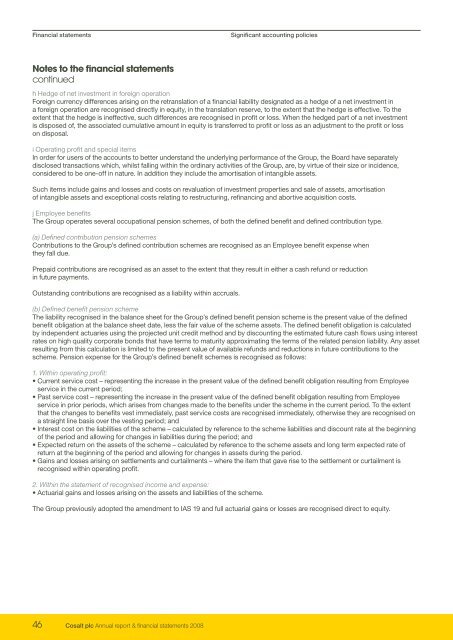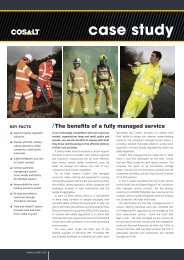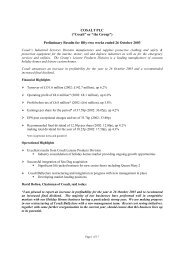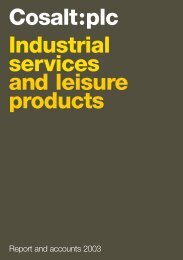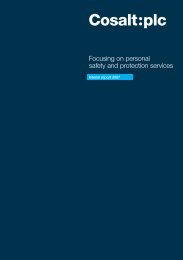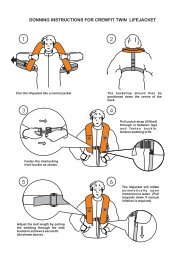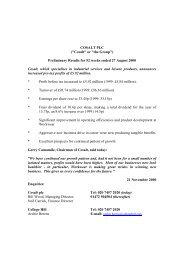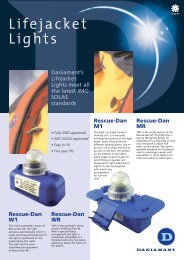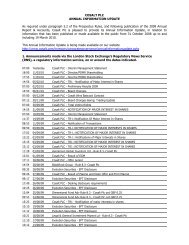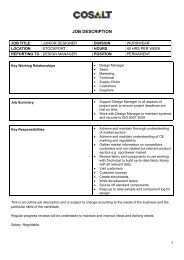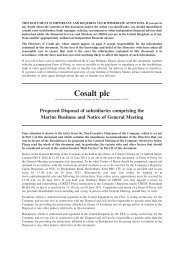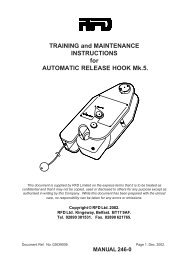Cosalt plc Annual report & financial statements 2008
Cosalt plc Annual report & financial statements 2008
Cosalt plc Annual report & financial statements 2008
Create successful ePaper yourself
Turn your PDF publications into a flip-book with our unique Google optimized e-Paper software.
Financial <strong>statements</strong><br />
Notes to the <strong>financial</strong> <strong>statements</strong><br />
continued<br />
46 <strong>Cosalt</strong> <strong>plc</strong> <strong>Annual</strong> <strong>report</strong> & <strong>financial</strong> <strong>statements</strong> <strong>2008</strong><br />
Significant accounting policies<br />
h Hedge of net investment in foreign operation<br />
Foreign currency differences arising on the retranslation of a <strong>financial</strong> liability designated as a hedge of a net investment in<br />
a foreign operation are recognised directly in equity, in the translation reserve, to the extent that the hedge is effective. To the<br />
extent that the hedge is ineffective, such differences are recognised in profit or loss. When the hedged part of a net investment<br />
is disposed of, the associated cumulative amount in equity is transferred to profit or loss as an adjustment to the profit or loss<br />
on disposal.<br />
i Operating profit and special items<br />
In order for users of the accounts to better understand the underlying performance of the Group, the Board have separately<br />
disclosed transactions which, whilst falling within the ordinary activities of the Group, are, by virtue of their size or incidence,<br />
considered to be one-off in nature. In addition they include the amortisation of intangible assets.<br />
Such items include gains and losses and costs on revaluation of investment properties and sale of assets, amortisation<br />
of intangible assets and exceptional costs relating to restructuring, refinancing and abortive acquisition costs.<br />
j Employee benefits<br />
The Group operates several occupational pension schemes, of both the defined benefit and defined contribution type.<br />
(a) Defined contribution pension schemes<br />
Contributions to the Group’s defined contribution schemes are recognised as an Employee benefit expense when<br />
they fall due.<br />
Prepaid contributions are recognised as an asset to the extent that they result in either a cash refund or reduction<br />
in future payments.<br />
Outstanding contributions are recognised as a liability within accruals.<br />
(b) Defined benefit pension scheme<br />
The liability recognised in the balance sheet for the Group’s defined benefit pension scheme is the present value of the defined<br />
benefit obligation at the balance sheet date, less the fair value of the scheme assets. The defined benefit obligation is calculated<br />
by independent actuaries using the projected unit credit method and by discounting the estimated future cash flows using interest<br />
rates on high quality corporate bonds that have terms to maturity approximating the terms of the related pension liability. Any asset<br />
resulting from this calculation is limited to the present value of available refunds and reductions in future contributions to the<br />
scheme. Pension expense for the Group’s defined benefit schemes is recognised as follows:<br />
1. Within operating profit:<br />
• Current service cost – representing the increase in the present value of the defined benefit obligation resulting from Employee<br />
service in the current period;<br />
• Past service cost – representing the increase in the present value of the defined benefit obligation resulting from Employee<br />
service in prior periods, which arises from changes made to the benefits under the scheme in the current period. To the extent<br />
that the changes to benefits vest immediately, past service costs are recognised immediately, otherwise they are recognised on<br />
a straight line basis over the vesting period; and<br />
• Interest cost on the liabilities of the scheme – calculated by reference to the scheme liabilities and discount rate at the beginning<br />
of the period and allowing for changes in liabilities during the period; and<br />
• Expected return on the assets of the scheme – calculated by reference to the scheme assets and long term expected rate of<br />
return at the beginning of the period and allowing for changes in assets during the period.<br />
• Gains and losses arising on settlements and curtailments – where the item that gave rise to the settlement or curtailment is<br />
recognised within operating profit.<br />
2. Within the statement of recognised income and expense:<br />
• Actuarial gains and losses arising on the assets and liabilities of the scheme.<br />
The Group previously adopted the amendment to IAS 19 and full actuarial gains or losses are recognised direct to equity.


